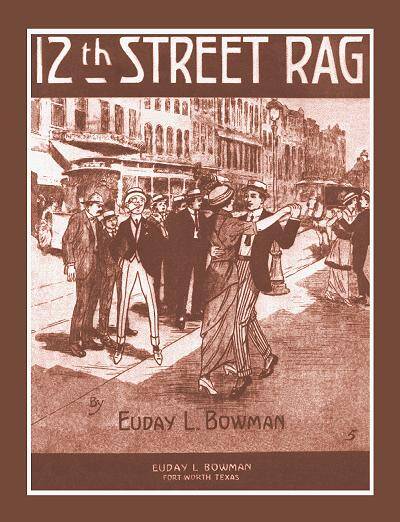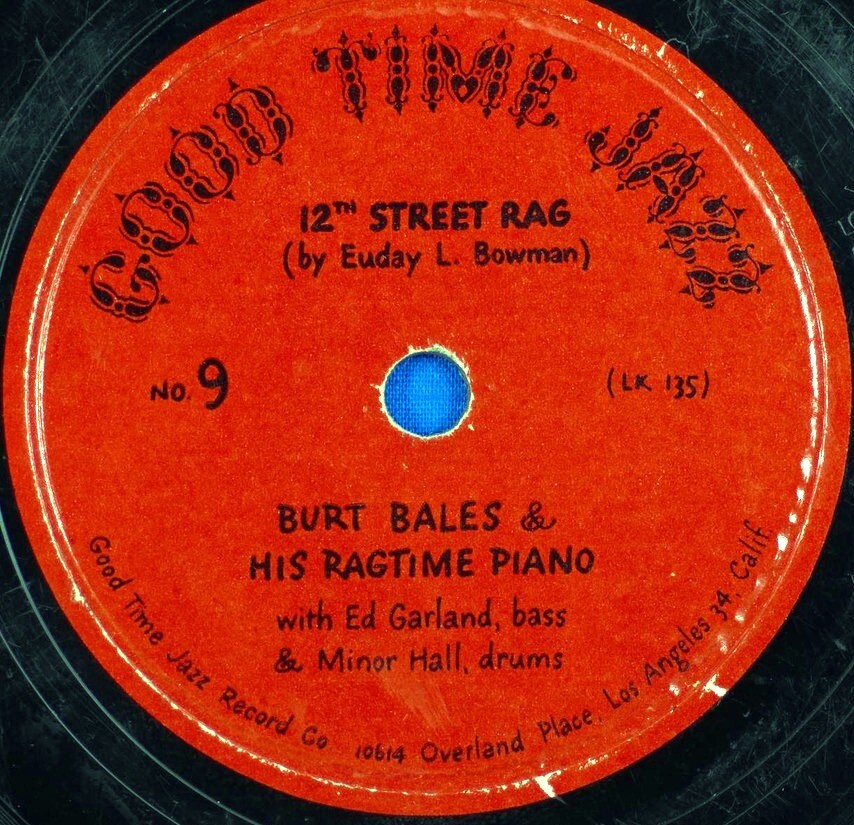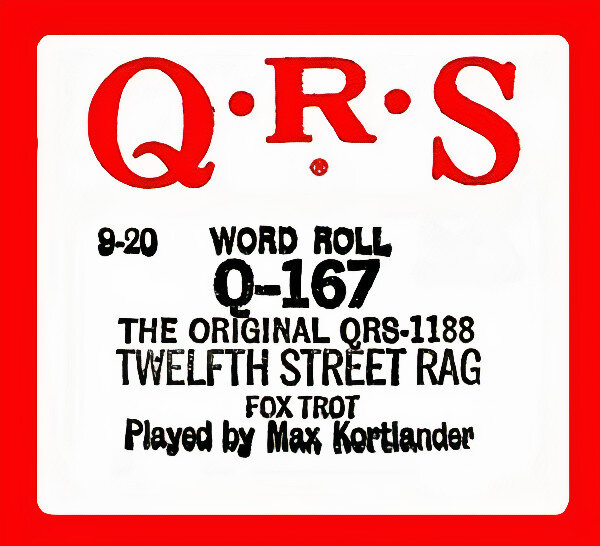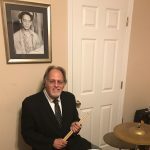 Jeff Barnhart: Well, Hal, I am excited to delve into Euday Bowman’s “12th Street Rag” with you! Before we start chewing over the myriad interpretations that have arisen over the years, I’d like to give a brief background of Bowman and his piece. Euday Bowman was born in 1886 in Texas. By the time he self-published “12th Street” in 1915, he was playing in Kansas City, MO (he’d also written “6th,” “10th” and “11th Street” Rags, referencing streets in KC’s red light district).
Jeff Barnhart: Well, Hal, I am excited to delve into Euday Bowman’s “12th Street Rag” with you! Before we start chewing over the myriad interpretations that have arisen over the years, I’d like to give a brief background of Bowman and his piece. Euday Bowman was born in 1886 in Texas. By the time he self-published “12th Street” in 1915, he was playing in Kansas City, MO (he’d also written “6th,” “10th” and “11th Street” Rags, referencing streets in KC’s red light district).
An interesting aside is that the first section of the rag is almost always omitted, excepting a couple of recordings from 1920 (one notably by the All-Star Trio: George Hamilton Green, xylophone; Victor Arden, piano; F. Wheeler Wadsworth, sax) and an occasional rendering of it by pops orchestras or symphonic bands. It’s the second section that most past and present performers begin with: that ear-worm of a “melody” consisting of only three repeated notes over a duple meter to create a syncopated effect. By the time the virtuosic, but completely unrelated, first section disappeared from the scene, EVERYONE was playing and recording “12th Street Rag!”
Sadly, Bowman sold the copyright to his seminal work for $300, thus missing out on the millions of dollars in royalties from sheet music sales and the numerous recordings that would do quite well. A year before his death in 1949, Bowman finally regained the rights to the rag, and although he was too ill to enjoy the ensuing money, this decades-old “overnight success” provided one MONSTER hit with which I’d like to begin.
In 1948, Dixieland trombonist Pee Wee Hunt and his band’s release on Capitol Records hit #1 on the Billboard charts and sold over three million records. This sextet’s romp included a much-copied clarinet solo (rendered by the inspiring Rosy McHargue), a brilliant “honky-tonk” piano chorus, some wild breaks and the trademark “Doo-wacka-doo” chorus.
Hal, numerous sources over the years have perpetuated the urban legend, no doubt created by Pee Wee or a publicist, that this cut was recorded “on-the-spot” as a joke when the band had a small amount of studio time left over. It was a great band, but this version sounds much too polished to be a spontaneous, last minute choice. Any insights about this legend, or observations about this version in particular?
Hal Smith: That does make a good story, but I agree with you that it must have been rehearsed and planned out before recording. The record was made during the height of the Traditional Jazz Revival and it sounds like this group was simultaneously making fun of the whole movement and riding its coattails.
JB: Ha! Even “cashing in” on the Revival, wouldn’t you say? Lucky them! As an octogenarian reeds-man friend of mine likes to say, “I’m trying to sell out, but nobody’s buying!”
 HS: It’s surprising to me that the version recorded in 1950 by the Firehouse Five Plus Two is actually less gimmicky than Pee Wee Hunt’s! Three of my favorite recordings of “12th Street Rag” date from 1950: An airshot from Hambone Kelly’s of Lu Watters’ Jazz Band and two versions which were recorded for the Good Time Jazz label: the Firehouse Five’s and Burt Bales’. Unfortunately, the Watters recording is not available to the general public at the present time.
HS: It’s surprising to me that the version recorded in 1950 by the Firehouse Five Plus Two is actually less gimmicky than Pee Wee Hunt’s! Three of my favorite recordings of “12th Street Rag” date from 1950: An airshot from Hambone Kelly’s of Lu Watters’ Jazz Band and two versions which were recorded for the Good Time Jazz label: the Firehouse Five’s and Burt Bales’. Unfortunately, the Watters recording is not available to the general public at the present time.
Fast-forwarding a few years, there are a couple performances of the rag by Kid Ory’s Creole Jazz Band that are available, both on YouTube and on CD. One is a 1953 broadcast from Club Hangover in San Francisco. At that time, “12th Street” was one of the fastest numbers that the Ory band played. The musicians all handled that very bright tempo with aplomb, but none more than pianist Don Ewell!
His solo chorus sounds like everything he ever played: cool, sophisticated and completely in control – though at the same time it is a joyful, Fats Waller-style tour-de-force. Ory recorded the rag commercially, too (for Verve in 1957) with a specially-assembled band that included Marty Marsala, Darnell Howard, Cedric Haywood, Frank Haggerty, Charles Oden and Earl Watkins. In contrast to the earlier performances, Ory kicked this one off at a much slower tempo and it swings like crazy! It is also quite a long performance, with everyone in the band contributing excellent solos.
JB: How wonderful that you’ve brought these contrasting versions by bands with the same leader! The faster 1953 version is definitely seat-of-your-pants; I had to listen to it twice as the first time knocked me over. Ewell’s quote of “Somebody Stole My Gal” at the start of his solo was a delightful surprise as well. I have to admit to enjoying the later recording on a deeper level.
While the first approached the breakneck tempo solo ragtime pianists have always favored with “12th St.,” the 1957 recording has that laid-back New Orleans feel that I call “relaxing in intense heat!” Ory has much more to say at this tempo as well. Really beautiful; I can see that dance floor filled!
The subject of tempo introduces what might be the slowest (yet one of the HOTTEST) versions of this rag ever recorded: Louis Armstrong’s Hot Seven on May 11, 1927! YOWZA! This is an early instance of “12th St.” that starts with the throwaway interlude preceding the trio in the original sheet music (DA-da-da-DA-da, DA-da-da-DA-da, DA-da, da-DA-DA-DA) and, I believe, the first to utilize that transition between each chorus.
From this version on, it became de rigueur to include that cornball phrase. Here, however, there is nothing corny occurring at all: In Armstrong’s opening solo chorus, as well as his mind-blowing break, he pushes and pulls at the melody with operatic flourish, literally bending it to his will like a deranged blacksmith. After a non-eventful trombone solo, we are treated to the subject of last month’s column, the masterful Johnny Dodds, earthily blowing blue over Lil Hardin’s straight statement of Bowman’s secondary melody. The first time I heard this, I was pretty upset: I was about 11 and I really wanted to hear it played FASTER! Ah, youth…
Exactly one month later, another very exciting and hot rendition was released AND without that trademark intro! Hal, the ball is yours!
HS: “Exciting and hot” is a perfect description for the recording by Bennie Moten’s Kansas City Orchestra! (I will be commenting on the second take). There are too many highlights to describe at length, but I will mention a few, starting with a completely different introduction, ending with a pyramid break by the ensemble.
On the first strain, the orchestra struts, with the rhythm section providing a relaxed, danceable two-beat (and a great drum break by Willie McWashington)! There is a key change, half a chorus by soprano sax, then a very hot trombone solo. The orchestra goes back to the original key (Eb) for the “first you slide, then you glide” strain with hot syncopated breaks at the end of that chorus. There is a false modulation (next chorus stays in Eb), then the bandleader plays a wonderful piano solo.
Apparently, Moten heard the great ragtime composer James Scott in person and was heavily influenced by Scott’s ragtime playing. Banjoist Leroy Berry plays countermelodies rather than straight time and the effect is reminiscent of how Al Stricker used to accompany Trebor J. Tichenor with the St. Louis Ragtimers. There is another false modulation, then the ensemble plays a terrific out-chorus, propelled by Vernon Page on brass bass and “Willie Mac” playing choke cymbal. A clever “chime” coda by the horns ends this very interesting arrangement.
JB: We have to concentrate on Moten exclusively for an entry in the coming year. Being, as it was, from Kansas City, the band’s early recordings really captured that ragtime two-beat “wobble” permeating MO during the 1900-20’s and proved that two-beat DOES swing! Combine that “strut” with fantastic arranging and you just couldn’t beat this ensemble in its prime. Thanks for including that one, Hal!
This is only our third column, and already we return to the Big Man himself, ol’ Fatsy-Watsy! His recording of “12th Street Rag” with his Rhythm is the swingin’est version I’ve ever heard!
I’m glad you earlier referenced one section by the lyrics, Hal. In 1919, lyricist James Sumner added words to Bowman’s piece and the piece was a big hit again! Fast forward to 1935, and Waller and Co. turn out a version where you never actually hear the “melody!”
Starting with his trademark trill in thirds, Fats launches into a wild vocal, referencing some of the original lyrics while backed by tasty guitar riffs from James Smith, and turns this old warhorse into a tour-de-force of small group SWING! Waller vocally urges Eugene Sedric and Herman Autrey through their solos and into a spectacular out-chorus that still gives me chills.
It all dissolves into Fats quoting Rachmaninov’s Prelude in C# minor and a hackneyed lick from Autrey but that seemed the only way to stop that freight train! There are stories of Fats sabotaging recordings of tunes he didn’t want to record with asides and musical “jokes,” but it really sounds as if they were having a whale of a time making this cut. What do you think, Hal?
HS: “Look what you can get for nothin’, baby! Let me get them hot dogs ready!” Yes—I agree that they were having fun with the song. Except for that silly quote at the end by Autrey, there is plenty of hot swing on Mr. Waller’s recording of “12th Street.” And if you want to hear another recording of the song that was clearly influenced by Fats’, check out Count Basie’s—from 1939. Once it gets past the “straight” piano chorus at the beginning (and Jo Jones’ clicks on the temple blocks), Basie strides away in the best tradition of “Fatsy-Watsy.” And those two tenor sax choruses by Lester Young will swing you into bad health!
JB: It was great fun to listen to that one, Hal. In just over three minutes we hear the Count morph from a tongue-in-cheek “One-Fingered Joe” pianist, to Wallerian disciple—complete with quotes galore from Fats’ rendering of four years prior, to backing Pres’s first solo chorus in the classic Thirties manner (the light, lilting “oom-pah” that sounds like it’s in four that only Waller, Basie, Wilson and their acolytes could ever manage), to those beautifully timed jabs in the right hand during the second (magnificent) sax chorus, to finally, behind Harry “Sweets” Edison’s smoldering muted trumpet ride, emerging into the sparse, extended chord Basie accompanist we associate with in later years. It’s a remarkable transformation in just five choruses!
 As our most recent explorations of “12th Street Rag” have concentrated on pianists, let’s come full-circle before wrapping up our adventure with a little game. I consulted ragtime scholar Bill Edwards on the provenance of two of the most popular, and contrasting, piano-rolls of the day, both in the key of C instead of Bowman’s Eb: Max Kortlander’s roll on QRS-1188 (later reissued as Q-167) from sometime between 1920 and 1922 and that of J. Lawrence Cook (QRS used the same number for Cook’s as Kortlander’s was most likely out-of-print by the time Cook recorded his roll).
As our most recent explorations of “12th Street Rag” have concentrated on pianists, let’s come full-circle before wrapping up our adventure with a little game. I consulted ragtime scholar Bill Edwards on the provenance of two of the most popular, and contrasting, piano-rolls of the day, both in the key of C instead of Bowman’s Eb: Max Kortlander’s roll on QRS-1188 (later reissued as Q-167) from sometime between 1920 and 1922 and that of J. Lawrence Cook (QRS used the same number for Cook’s as Kortlander’s was most likely out-of-print by the time Cook recorded his roll).
In Kortlander’s version, we have no first section and no intro ala Armstrong, et al. We also have minimal “third-hand” trickery, usually so celebrated in piano rolls; there are a few tastefully subtle, “mechanical” additions during the last third of the roll to build up the climax, but the first part is beautifully orchestrated and played by Kortlander, sans the piano roll “ghost!”
Cook’s version stylistically points to his roll being 6-10 years later, with plenty of moving bass lines, full chords—many of them passing chromatic harmonies—and licks that are firmly in the stride tradition: we hear nods to Johnson, Waller, and even Eubie Blake. Cook was a fantastic, versatile pianist and arranger and his fireworks are on display here! His version includes the (now) traditional intro, all themes but that orphaned first section, and concludes with a great novelty piano flourish! Do you have a preference regarding these, Hal?
HS: Jeff, that’s an easy choice! I prefer the J. Lawrence Cook roll. That one swings right from the get-go and as you pointed out, there are unmistakable references to the giants of Harlem stride and Eubie too. It is an amazingly hot performance! There is one more roll of “12th Street” that I like very much: the one which Johnny Maddox used as the opening track on the first volume of his “World’s Greatest Piano Rolls” LP series.
I think that is a machine-cut roll as opposed to hand-played. Unfortunately, it was played at top speed for the record—probably because of time limitations. There is also a drummer playing along (I don’t mind that). This roll includes the original introduction and all the parts played relatively straight. As I recall, it was the first time I heard the song without the “standard” introduction.
JB: Terrific inclusion, Hal! This rag has sure made the rounds, hasn’t it? How about wrapping this up with a little “chase chorus”? Let’s do a round-robin list of some remaining versions we like; artist, year and one descriptive sentence apiece. Are you game? If so, I’ll begin: Duke Ellington Orch., 1931; amazing arranging from the master with a HOT solo piano chorus and Tricky Sam Nanton muted trombone!
HS: O.K. What about Sidney Bechet’s 1941 recording with Henry Goodwin on trumpet, Vic Dickenson on trombone, Sid Catlett on drums, and a great stride piano solo by the underrated Don Donaldson?
JB: With delightful Charlie Christian-like counterpoint as well! Hal, I’m going to go fringe on my final three choices, ‘cause, why not? First is from 1954, again with Ellington’s Orch., this time channeling Xavier Cugat for their Twelfth Street Rag Mambo; it’s outside the box, but I was dancing (badly) around the room! By the ’50s, Ellington had sure traveled a long way from his stride piano roots!
HS: Well, speaking of stride, there is a very nice version by Willie “The Lion” Smith recorded for the Vogue label; no introduction, but all the typical Lion licks as well as the melody that James P. Johnson incorporated into the second strain of his composition “Harlem Strut.”
JB: Nice one! There are several versions of “The Lion” playing this rag (including in piano trio format and a duet with Don Ewell) and you picked the cream of the crop! My penultimate choice stars a somewhat subdued (for him) Liberace on his 1950s TV show. He also kept returning to “12th Street” and on one memorable occasion, duetted with a marionette version of himself placed atop the music stand on his grand piano. Bizarre!
HS: I forgot about the duet record with Ewell! Thanks for reminding me about it. I’m going to listen to that as soon as we wrap up this discussion. Also, I appreciate the fact that you introduced me to two versions of “12th Street Rag” that I would have never found on my own: Frankie Carle’s and Sonny Stitt’s. Carle’s interpretation is unusual—for him—in that there is some obvious Earl Hines influence! Stitt’s is an up-tempo workout for tenor sax, with a generous helping of Lester Young phrases flying by at an alarming pace.
JB: Both of those cuts you described bring out the best in both of those musicians! How strange that a simple 3-note tune would provide such fertile ground for so many. “12th Street” has been used for decades as a signature piece for my final choice: pianist Terry Waldo. His spoken and musical intro are hilarious, with him then struggling through the first theme at a super-sluggish tempo, getting his fingers stuck, screwing up the timing. After that tour-de-farce, he launches into rocket ship speed and brings the house down. I’ve seen it live a dozen times and it never fails to entertain! Hal, we’ve only scratched the surface with our selections; there are hundreds of recorded versions of “12th Street Rag” out there, and no doubt hundreds more will be created.
HS: We have certainly heard it played in just about every setting you can imagine—straight off the page, as a hot stomp, as a slow drag, a swinger, as a comedy routine, and even teetering on the edge of Bebop. And it works every time! By the way, I understand “12th Street Rag” was also featured recently in a network cartoon series.
JB: You can’t avoid this tune! In addition to being used in the 1960’s as the theme of the popular talk show The Joe Franklin Show, the most recent television appearance, as you point out, is found on the kids’ show SpongeBob SquarePants in a nice country slide-guitar/mandolin version. Here, “12th Street Rag” is referred as an “eargasm.” Naughty, naughty SpongeBob.
OK, I’ll finish this with a mystery: Could Euday Bowman have been inspired to write “12th Street Rag” by inverting the order of notes found in another wildly successful rag from four years prior? If you reverse the repeated three note melody in Wilbur Sweatman’s “Down Home Rag,” from 1911, you get Bowman’s “12th Street Rag!” More exciting than “Paul is dead,” for sure!
HS: And if you listen to Wilbur Sweatman’s compositions “That’s Got ‘Em” and “The Boogie Rag” you’ll find that they have a lot in common with “Down Home Rag.” I guess Sweatman figured that he didn’t want to mess with a winning formula!
JB: Hal, I chose this rabbit hole, so what do you suggest for next month?
HS: What if we discuss some recordings of “Panama?”
JB: Sounds super! Can’t wait!
Hal Smith is an Arkansas-based drummer and writer. He leads the El Dorado Jazz Band and the
Mortonia Seven and works with a variety of jazz and swing bands. Visit him online at
halsmithmusic.com























